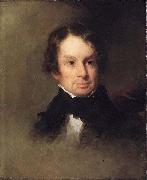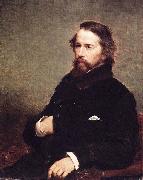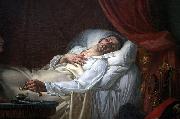Charles Loring Elliott Huiler la Reproduction de TableauAll Charles Loring Elliott Oil Paintings1812-1868. Elliott was born at Auburn, New York in the central part of the state. He began working as a painter in his region. After 10 years, he moved to New York City to study art under the painters John Trumbull and John Quidor, as well as to be in a bigger market for work. After practicing portrait painting in central New York State for 10 years, Elliott took up residence in New York City in 1845. The following year he was elected to the National Academy of Design, which was a measure of recognition and helped him attract more clients. Painting by Elliott of Samuel Putnam Avery, 1863Elliott was considered the best portraitist of his day. Although he never studied abroad, his technique is neither provincial nor uncertain. His method is mature, his drawing firm, his color fresh and clean, and his likenesses excellent, though somewhat lacking in sentiment.He was said to have painted over 700 portraits, mostly heads, as he had little idea of the composition of large canvases. He also painted figure pieces, including Don Quijote and Falstaff, and one landscape, The Head of Skaneateles Lake. |
|||

|
|||
|
|
|||
|
||||||||||||
| Charles Loring Elliott 1812-1868. Elliott was born at Auburn, New York in the central part of the state. He began working as a painter in his region. After 10 years, he moved to New York City to study art under the painters John Trumbull and John Quidor, as well as to be in a bigger market for work. After practicing portrait painting in central New York State for 10 years, Elliott took up residence in New York City in 1845. The following year he was elected to the National Academy of Design, which was a measure of recognition and helped him attract more clients. Painting by Elliott of Samuel Putnam Avery, 1863Elliott was considered the best portraitist of his day. Although he never studied abroad, his technique is neither provincial nor uncertain. His method is mature, his drawing firm, his color fresh and clean, and his likenesses excellent, though somewhat lacking in sentiment.He was said to have painted over 700 portraits, mostly heads, as he had little idea of the composition of large canvases. He also painted figure pieces, including Don Quijote and Falstaff, and one landscape, The Head of Skaneateles Lake. |
||||||||||||
|
|
||||||||||||
| ID de tableau:: 70887 Henry Wadsworth Longfellow Henry Wadsworth Longfellow between 1842(1842) and 1846(1846) Oil on canvas 60.4 x 50 cm (23.78 x 19.68 in) between 1842(1842) and 1846(1846) Oil on canvas 60.4 x 50 cm (23.78 x 19.68 in) |
||||||||||||
|
|
||||||||||||
| ID de tableau:: 70899 General John Charles Fremont General John Charles Fremont ca. 1857(1857) Oil on canvas 91.4 x 74 cm (35.98 x 29.13 in) ca. 1857(1857) Oil on canvas 91.4 x 74 cm (35.98 x 29.13 in) |
||||||||||||
|
|
||||||||||||
| ID de tableau:: 85440 Der Tod des General Moreau Der Tod des General Moreau Medium Oil on canvas cyf Medium Oil on canvas cyf |
||||||||||||
|
|
||||||||||||
|
| Artiste précédent Artiste prochain | |||||||||||
|
|
||||||||||||
|
Charles Loring Elliott 1812-1868. Elliott was born at Auburn, New York in the central part of the state. He began working as a painter in his region. After 10 years, he moved to New York City to study art under the painters John Trumbull and John Quidor, as well as to be in a bigger market for work. After practicing portrait painting in central New York State for 10 years, Elliott took up residence in New York City in 1845. The following year he was elected to the National Academy of Design, which was a measure of recognition and helped him attract more clients. Painting by Elliott of Samuel Putnam Avery, 1863Elliott was considered the best portraitist of his day. Although he never studied abroad, his technique is neither provincial nor uncertain. His method is mature, his drawing firm, his color fresh and clean, and his likenesses excellent, though somewhat lacking in sentiment.He was said to have painted over 700 portraits, mostly heads, as he had little idea of the composition of large canvases. He also painted figure pieces, including Don Quijote and Falstaff, and one landscape, The Head of Skaneateles Lake. |
||||||||||||
|
|
||||||||||||
|
CONTACTER DES Etats-Unis |








